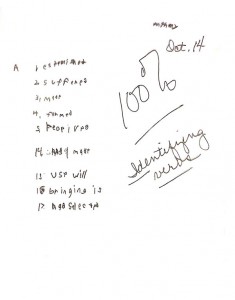
The brain processing issues that underlie Dysgraphia-Handwriting challenges can be be addressed directly with sensory-motor exercises. This type of neuro-stimulation training enables users to overcome fine motor hurdles and dramatically improve handwriting for the long term.
 Dysgraphia is a neurological challenge defined as a disturbance or difficulty in the production of written language related to the mechanics of handwriting and graphing. Skilled handwriting is a complex activity that entails an intricate blend of cognitive, kinesthetic, and perceptual-motor components. Two main outcomes are used to assess and define poor handwriting: product legibility and performance time.
Dysgraphia is a neurological challenge defined as a disturbance or difficulty in the production of written language related to the mechanics of handwriting and graphing. Skilled handwriting is a complex activity that entails an intricate blend of cognitive, kinesthetic, and perceptual-motor components. Two main outcomes are used to assess and define poor handwriting: product legibility and performance time.
There are several basic brain processes that underlie the mechanics of handwriting. Binocular teaming, or the proper focusing of the eyes, requires integration between the two hemispheres of the brain. Writing neatly on the paper is a fine motor activity that requires significant eye-hand coordination and well developed fine motor skills. Most handwriting problems are caused by a sensory integration disorder that inhibits coordination and integration between the many brain structures and systems involved in the writing process. The question for a dysgraphia treatment is this: how can the brain processing difficulties that make writing so challenging for some people be addressed?





 Students with an attention deficit disorder (especially with hyperactivity) often experience rather significant difficulty with formulas in general and handwriting in particular. This is because ADHD students also have difficulty organizing and sequencing detailed information. Some students can also experience writing difficulty because of a general auditory or language processing weakness. This leads to obvious difficulty with one of the more difficult forms of language expression…written language.
Students with an attention deficit disorder (especially with hyperactivity) often experience rather significant difficulty with formulas in general and handwriting in particular. This is because ADHD students also have difficulty organizing and sequencing detailed information. Some students can also experience writing difficulty because of a general auditory or language processing weakness. This leads to obvious difficulty with one of the more difficult forms of language expression…written language.